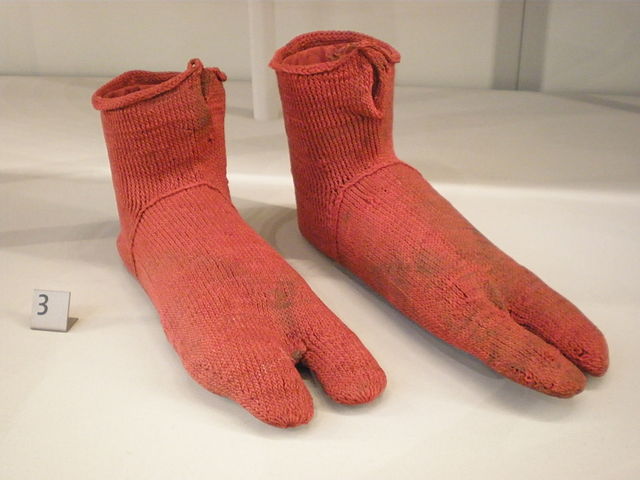A sock is a piece of clothing worn on the feet and often covering the ankle or some part of the calf. Some types of shoes or boots are typically worn over socks. In ancient times, socks were made from leather or matted animal hair. In the late 16th century, machine-knit socks were first produced. Until the 1800s, both hand-made and machine-knit socks were manufactured, with the latter technique becoming more common in the 19th century, and continuing until the modern day.
A hand-knitted sock
Silk woven socks from the Mawangdui tomb, Western Han, 2nd century BCE. Ancient Chinese socks are loose fitting and were tied with strings at the back.
Egyptian socks created by naalbinding. Dating from 300–500, these were excavated from Oxyrhynchus on the Nile in Egypt. The split toes were designed for use with sandals. On display in the Victoria and Albert museum, reference 2085&A-1900.
12th-century cotton sock, found in Egypt. The knitter of this sock started work at the toe and then worked up towards the leg. The heel was made last and then attached to loops formed while knitting the leg. This practice allowed the heel to be easily replaced when it wore out.
A boot is a type of footwear. Most boots mainly cover the foot and the ankle, while some also cover some part of the lower calf. Some boots extend up the leg, sometimes as far as the knee or even the hip. Most boots have a heel that is clearly distinguishable from the rest of the sole, even if the two are made of one piece. Traditionally made of leather or rubber, modern boots are made from a variety of materials.
Ancient Greek pair of terracotta boots. Early geometric period cremation burial of a woman, 900 BC, Ancient Agora Museum, Athens
Oxhide boots from Loulan, Xinjiang, China. Former Han dynasty 220 BC – AD 8
A pair of ISO 20345:2004 compliant S3 steel-toed safety boots designed for construction workers
A pair of hobnailed boots








